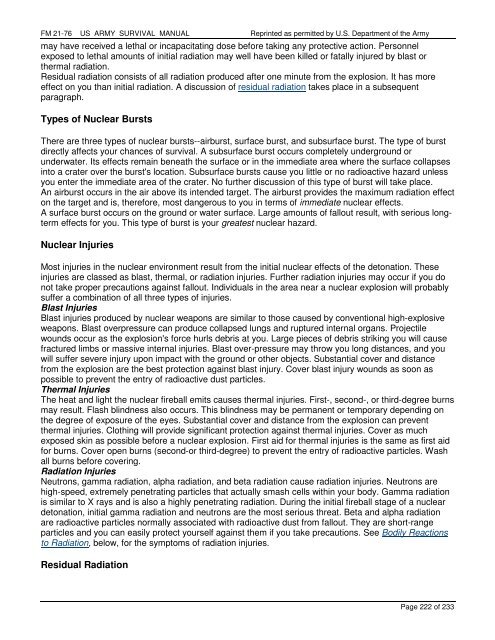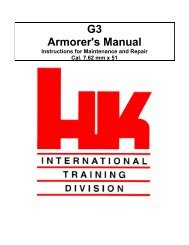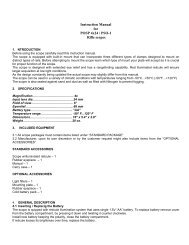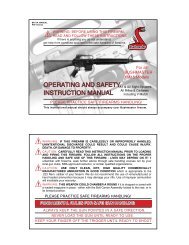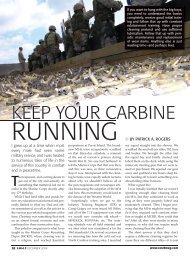FM 21-76 US ARMY SURVIVAL MANUAL - AR15.com
FM 21-76 US ARMY SURVIVAL MANUAL - AR15.com
FM 21-76 US ARMY SURVIVAL MANUAL - AR15.com
Create successful ePaper yourself
Turn your PDF publications into a flip-book with our unique Google optimized e-Paper software.
<strong>FM</strong> <strong>21</strong>-<strong>76</strong> <strong>US</strong> <strong>ARMY</strong> <strong>SURVIVAL</strong> <strong>MANUAL</strong> Reprinted as permitted by U.S. Department of the Army<br />
may have received a lethal or incapacitating dose before taking any protective action. Personnel<br />
exposed to lethal amounts of initial radiation may well have been killed or fatally injured by blast or<br />
thermal radiation.<br />
Residual radiation consists of all radiation produced after one minute from the explosion. It has more<br />
effect on you than initial radiation. A discussion of residual radiation takes place in a subsequent<br />
paragraph.<br />
Types of Nuclear Bursts<br />
There are three types of nuclear bursts--airburst, surface burst, and subsurface burst. The type of burst<br />
directly affects your chances of survival. A subsurface burst occurs completely underground or<br />
underwater. Its effects remain beneath the surface or in the immediate area where the surface collapses<br />
into a crater over the burst's location. Subsurface bursts cause you little or no radioactive hazard unless<br />
you enter the immediate area of the crater. No further discussion of this type of burst will take place.<br />
An airburst occurs in the air above its intended target. The airburst provides the maximum radiation effect<br />
on the target and is, therefore, most dangerous to you in terms of immediate nuclear effects.<br />
A surface burst occurs on the ground or water surface. Large amounts of fallout result, with serious longterm<br />
effects for you. This type of burst is your greatest nuclear hazard.<br />
Nuclear Injuries<br />
Most injuries in the nuclear environment result from the initial nuclear effects of the detonation. These<br />
injuries are classed as blast, thermal, or radiation injuries. Further radiation injuries may occur if you do<br />
not take proper precautions against fallout. Individuals in the area near a nuclear explosion will probably<br />
suffer a combination of all three types of injuries.<br />
Blast Injuries<br />
Blast injuries produced by nuclear weapons are similar to those caused by conventional high-explosive<br />
weapons. Blast overpressure can produce collapsed lungs and ruptured internal organs. Projectile<br />
wounds occur as the explosion's force hurls debris at you. Large pieces of debris striking you will cause<br />
fractured limbs or massive internal injuries. Blast over-pressure may throw you long distances, and you<br />
will suffer severe injury upon impact with the ground or other objects. Substantial cover and distance<br />
from the explosion are the best protection against blast injury. Cover blast injury wounds as soon as<br />
possible to prevent the entry of radioactive dust particles.<br />
Thermal Injuries<br />
The heat and light the nuclear fireball emits causes thermal injuries. First-, second-, or third-degree burns<br />
may result. Flash blindness also occurs. This blindness may be permanent or temporary depending on<br />
the degree of exposure of the eyes. Substantial cover and distance from the explosion can prevent<br />
thermal injuries. Clothing will provide significant protection against thermal injuries. Cover as much<br />
exposed skin as possible before a nuclear explosion. First aid for thermal injuries is the same as first aid<br />
for burns. Cover open burns (second-or third-degree) to prevent the entry of radioactive particles. Wash<br />
all burns before covering.<br />
Radiation Injuries<br />
Neutrons, gamma radiation, alpha radiation, and beta radiation cause radiation injuries. Neutrons are<br />
high-speed, extremely penetrating particles that actually smash cells within your body. Gamma radiation<br />
is similar to X rays and is also a highly penetrating radiation. During the initial fireball stage of a nuclear<br />
detonation, initial gamma radiation and neutrons are the most serious threat. Beta and alpha radiation<br />
are radioactive particles normally associated with radioactive dust from fallout. They are short-range<br />
particles and you can easily protect yourself against them if you take precautions. See Bodily Reactions<br />
to Radiation, below, for the symptoms of radiation injuries.<br />
Residual Radiation<br />
Page 222 of 233


